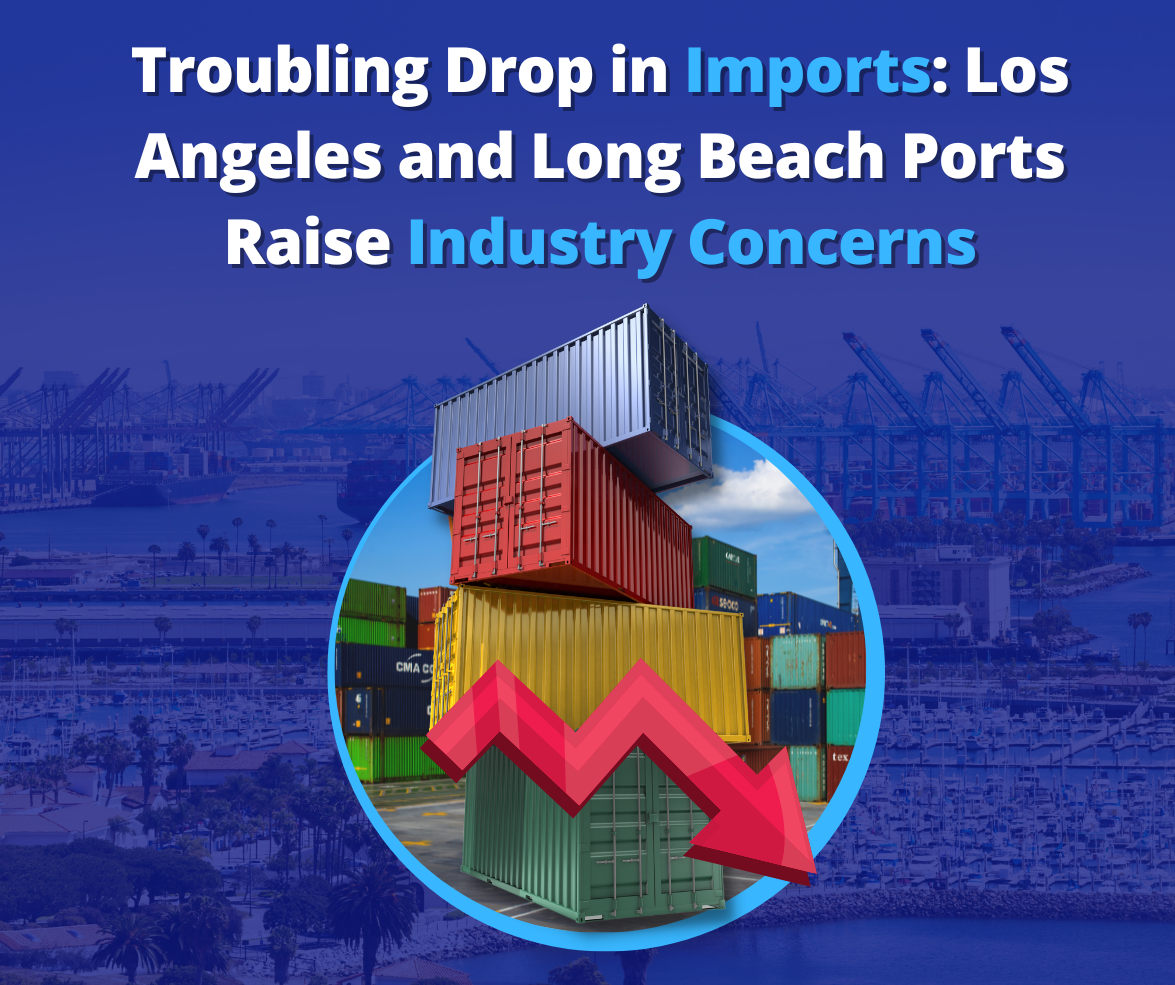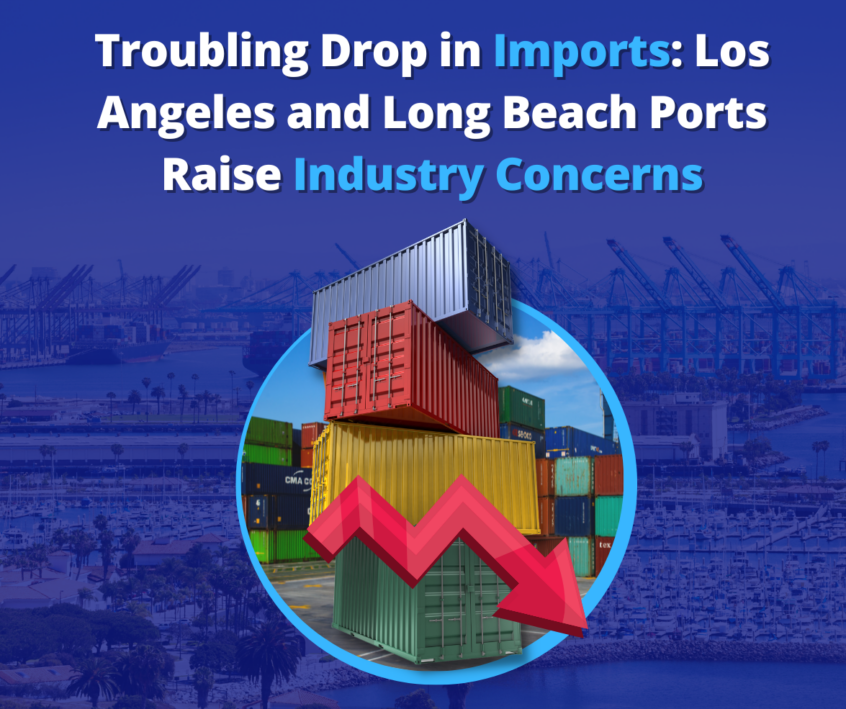
Los Angeles, Long Beach imports still sinking
LA imports have been reported to have plunged by 41% compared to 2022. This also represents a 33% decline when compared to the previous month. The fact that imports to LA this month were 28% lower than before the Covid-19 pandemic should be a concern to the industry. These numbers that have been dubbed “ugly” by some commentators are not entirely unexpected. Gene Seroka, Executive Director at the Port of Los Angeles, attended a press conference where the steep decline dominated the headlines.
A steep decline in imports heralds worrying times
The February 2023 report indicated that total throughput at Los Angeles was only 487,846 twenty-foot equivalent units (TEUs), a significant dip compared to the previous month, year, and even before the pandemic hit. As a result, Los Angeles lost its ranking to become only the third busiest container port in the USA based on these statistics. Meanwhile, the top spots were taken by New York/New Jersey. This happened for several months in 2022 as well. In February, New York/New Jersey handled 571,177 TEUs, amounting to 17% higher than the volume in Los Angeles.
At the same time, Long Beach dealt with 543,675 TEUs in February. This is still 11% more than the volume in Los Angeles. This has been noted as the worst month for imports since the Wuhan lockdowns of 2020. Indeed, this represents a significant under-utilization of capacity since Los Angeles can handle more than twice the imports than it dealt with in February. That downward trend was experienced on multiple occasions between 2020 and 2021.
Other ports are also experiencing a marked decline
We know that Long Beach reported handling imports of about 254,970 TEUs. This represents a decline of 35% when compared to the previous year. On a month-to-month comparison, the decline is more modest at 3%. When compared to the statistics for February 2019, the drop is 16%. The total imports handled by Long Beach and Los Angeles during February were just 504,377 TEUs. This is the lowest amount handled by the two ports, except for March 2020. At the time, the trans-Pacific trade route was shut down due to the Covid-19 pandemic that had instigated a series of crippling lockdowns in the Wuhan area of China.
Several factors are blamed for the marked decline. According to Seroka, this stark decrease partly arose due to a fall in demand. This global phenomenon goes beyond the challenges that the import business is facing in the USA. Additionally, experts suggest that the inventory levels in the USA at the moment are still too high. Moreover, the Lunar New Year holidays in large parts of Asia mean that the people that oil the wheels of international trade are often off-duty. Indeed, it was reported that the factories in Asia closed for longer while the overall orders that they were meant to be dealing with were quite weak. Another factor that must not be ignored is the ongoing labor negotiations, which have created a climate of uncertainty among people who are already jittery about international trade prospects.
An international trade environment haunted by many challenges
As if the global challenges were insufficient, ports struggle to meet their ends of various commitments out of fear of what comes next with trade union negotiations. The port labor contract between employers and the trade unions expired on the 1st of July 2022. This is nearly eight and a half months ago, yet a firm deal has not yet been signed. Cargo owners want the agreement to be finalized so that they have certainty about their transactions and procedures. Seroka would not be drawn into committing to a deadline for the agreement, understandably so, given the delicate nature of the matter.
Now that the Lunar New Year is over, Seroka anticipates imports of about 600,000 TEUs in March. If that target was reached, it would represent an uplift of 20% compared to February. In any case, the first quarter volumes for Los Angeles are predicted to be 33% lower than in the previous year. In fact, first quarter projections for this year forecast a decline of 21% when compared to the five-year average. All these trends point towards a weak import sector.
Is some of this cargo lost for good?
Some experts are beginning to wonder whether the cargo lost by Los Angeles and Long Beach will ever be recovered. On the optimistic side, the argument is that shippers will bring back volumes to the Southern Californian ports once the new labor contract is signed. That will mean that labor disruptions are off the table, and cargo owners can plan with relative ease about what they will eventually be dealing with. However, that argument is challenged by the reality that much volume has shifted to the Gulf and East coasts, which will have measures to ensure they retain their newfound dominance.
In fact, a fear of labor unrest and congestion shifted volumes. That led to new supply chains that started as temporary but have since emerged as permanent or at least semi-permanent. The implication is that importers will stick to the new normal if it meets their needs rather than returning to Southern Californian ports even if those ports benefit from a West Coast labor deal. Certainly, Nerijus Poskus (vice president of ocean strategy at Flexport) was of the view that these changes are going to become permanent.
Importers have made critical decisions and are sticking to them
According to Poskus, many importers only have one distribution center or warehouse on the West Coast. This would help them deal with their international transport from Asia to Southern California if need be. For example, it would allow them to cover the domestic delivery space. However, the last two years have forced these companies to open and sign new contracts with alternative distribution centers located on the East Coast. Although they can conceivably move back, there is currently little reason for them to do so.
Indeed, many customers live on the East Coast. The new supply chains will be perfect for that market, and the cargo owners would not want to tamper with an apparently working system. Although it may appear to be a cost implication in increasing international expenditures, this is offset by savings on domestic expenditure. The upshot is that most of these cargo owners are logistically better off focusing on ports and centers outside the Southern California enclave.
Wrapping up
The dreadful import volumes for Los Angeles and Long Beach in February 2023 are part of an ongoing trend. The import business is moving away from Southern California because of the logistical advantages of getting closer to end customers and the better cost calculus. Therefore, the startling drop in February indicates a loss in import volumes likely to stick around. A new labor contract will not change that reality that importers and ports must contend with.




